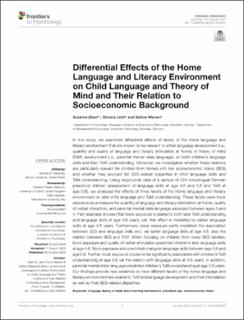| dc.description.abstract | In this study, we examined differential effects of facets of the home language and literacy environment that are known to be relevant to either language development (i.e., quantity and quality of language and literacy stimulation at home) or theory of mind (ToM) development (i.e., parental mental state language), on both children’s language skills and their ToM understanding. Moreover, we investigated whether these relations are particularly relevant for children from homes with low socioeconomic status (SES) and whether they account for SES-related disparities in child language skills and ToM understanding. Using longitudinal data of a sample of 224 monolingual German preschool children (assessment of language skills at age 4;6 and 5;6 and ToM at age 5;6), we analyzed the effects of three facets of the home language and literacy environment on later child language and ToM understanding. These facets were book exposure as a measure for quantity of language and literacy stimulation at home, quality of verbal interaction, and parental mental state language assessed between ages 3 and 4. Path analyses showed that book exposure is related to both later ToM understanding and language skills at age 5;6 years; yet, this effect is mediated by earlier language skills at age 4;6 years. Furthermore, book exposure partly mediated the association between SES and language skills and, via earlier language skills at age 4;6, also the relation between SES and ToM. When focusing on children from lower SES families, book exposure and quality of verbal stimulation predicted children’s later language skills at age 4;6. Book exposure also predicted change in language skills between age 4;6 and age 5;6. Further, book exposure proved to be significantly associated with children’s ToM understanding at age 5;6 via the relation with language skills at 4;6 years. In addition, parental mental state language predicted children’s ToM understanding at age 5;6 years. Our findings provide new evidence on how different facets of the home language and literacy environment are related to ToM and language development and their interrelation as well as their SES-related disparities. | en_US |

